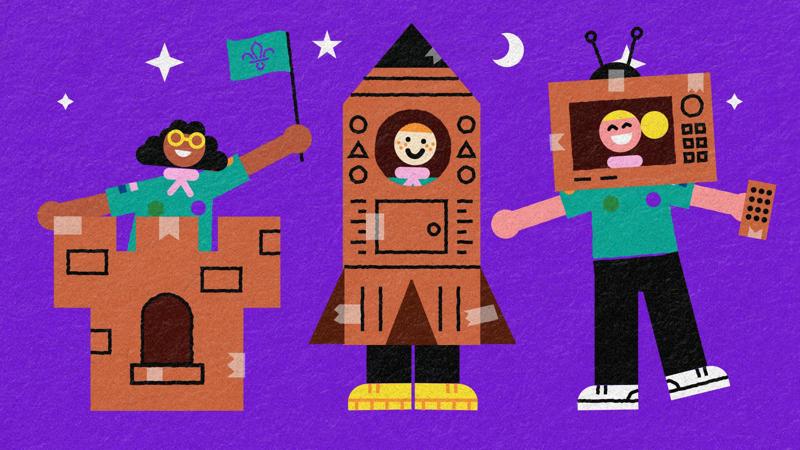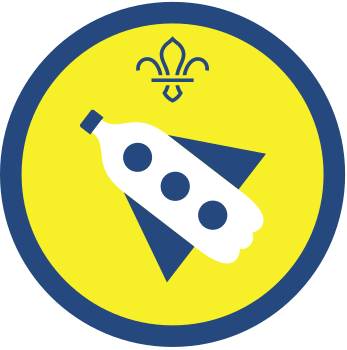
Try making different cardboard creations
You’ll need
- Cardboard
- Scissors
- String
- Pens or pencils
- Scrap paper
- Glue
- Sticky tape
Before you begin
- Use the safety checklist to help you plan and risk assess your activity. Additional help to carry out your risk assessment, including examples can be found here. Don’t forget to make sure all young people and adults involved in the activity know how to take part safely.
- Make sure you’ll have enough adult helpers. You may need some parents and carers to help if you’re short on helpers.
Planning this activity
- Consider using an online search engine, such as Google, to look up examples of different cardboard creations to use as inspiration. You may want to print some images of for inspiration to show to your Group.
- Ask everyone to bring in clean cardboard that would normally have been recycled. If you’ve got space, you could build a collection over a few weeks. You could also ask local businesses or supermarkets to save some cardboard for your group. Make sure that everything that you’re using can be recycled after the activity.
- Make sure that there is adequate supervision for participants using sharp objects or scissors.
Set the scene
Explain that you’ll all be using the cardboard to create something brand new. Some of different ways you could run this activity are:
In teams everyone should create a castle out of cardboard. The castle should be large enough for the whole team to fit inside. Will the castles have towers, spires, a drawbridge or a moat? The team may want to design and hang a flag from the side of their castle to represent their clan.
Optional: Once everyone has made their castles, each team should be given an equal number of plastic balls. They must ‘defend’ their castle. Allow a 5-10 minute event of ball throwing and then the person leading the activity can judge the castle that has been defended the best to be the winner.
Everyone should think about when they last went to a city. Make a list of everything you would find in a city. What is important to be included to make the city a nice place to live or visit? Some examples might be:
- Cars
- Street lights
- Parks
- A zoo
- Skyscrapers
- Theatres
- Castles
- Places of worship
Using the cardboard, pens and sticky tape, everyone should work together to create a tiny city in their meeting place.
Calling all astronauts, you’ve been invited to explore a newly discovered planet!
In teams, everyone should work together to build a spaceship that will help transport them through the galaxy.
You need to create wings and a control panel, as well as rockets at the bottom of the ship to help power your team into the stars. Don’t forget to make space helmets for everyone, so that they can explore the new planet safely!
Once the ship has been made, the team should climb in and get ready for ‘blast off’! What does everyone think the new planet will look like? What should the new planet be called? Could you hold a spaceship race across the meeting place?
In pairs or teams, everyone should take a cardboard box and cut a hole out for the ‘screen’ of their television.
Using pens, paper and any other materials they like, participants should decorate their television, as well as the ‘background’ of their TV screen.
Once their TV has been made, each pair may want to put on a show from within their TV. This could be a news show, a talk show, a comedy show or anything else they can think of. They could use either themselves or create puppets to act out the show
Consider your meeting place its current state. What could be done to improve or change the space for the benefit of some or all sections? What activities do you and your group enjoy doing together? What have you seen in other meeting places that you think would improve your space?
Your ideas could include:
- An archery range
- A swimming pool
- A climbing wall
- A place to store muddy boots
- A new room specifically for your section
Get building
- Ask everyone to get into pairs or groups.
- Each pair or group should take some paper and pens and consider the aim of their build. It may also be done individually, depending on which activity scenario you’ve chosen from the options suggested.
- Everyone should consider the materials that are available. They need to think about how they can transform the cardboard to match their plan by cutting and sticking different pieces together.
- Tell people to create the larger basic structures of their design first, offering stability, before starting to add in more details.
- Make sure there’s enough time for everyone to admire what they have all made.
- Once everyone has made their creations, you could ask everyone what their favourite creation was, apart from their own, and why.
Reflection
This activity needed everyone to use their creativity, teamwork and communication skills, especially when their ideas didn’t always work.
Consider how everyone approached the challenge. Did everyone start building on their own? Did anyone plan before they started? If so, how well did they stick to their plan? Did the plan change?
What did they do to solve the problems? It can be frustrating when things don’t go quite right, so it’s great if people kept going and gave it another go.
This activity helped everyone to develop skills. People should take it in turns to share what they enjoyed most about this activity. Their answers may include using their imagination, problem-solving, turning their ideas into a reality, listening to other people’s ideas and working as a team.
Now that everyone’s had a turn at using both their imaginations and their constructions skills, who knows what they’ll be able to do next! Everyone should think about when else it might be helpful to use their imagination to build and fix things.
Safety
All activities must be safely managed. You must complete a thorough risk assessment and take appropriate steps to reduce risk. Use the safety checklist to help you plan and risk assess your activity. Always get approval for the activity, and have suitable supervision and an InTouch process.
- Scissors
Supervise young people appropriately when they’re using scissors. Store all sharp objects securely, out of the reach of young people.
- Glue and solvents
Always supervise young people appropriately when they’re using glue and solvent products. Make sure there’s plenty of ventilation. Be aware of any medical conditions that could be affected by glue or solvent use and make adjustments as needed.
- Rubbish and recycling
All items should be clean and suitable for this activity.
- Sharp objects
Teach young people how to use sharp objects safely. Supervise them appropriately throughout. Store all sharp objects securely, out of the reach of young people.
This activity can be led by you or someone else in Scouts
Shapes and basic structures may need to be made in advance so that participants can focus on decorating and playing in their creations.
You could scale up the challenge so it becomes part of a district competition.
People may prefer to work in pairs. If anyone struggles with fine motor skills, they could use larger materials. As people work in pairs, their partner can also help with the parts they find tricky.
It’s OK if anyone needs help with the fiddlier part of this activity. Other people, including the grownups, should help anyone who needs it.
All Scout activities should be inclusive and accessible.
